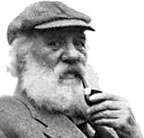|
|
|
 Selfridge designed the first one, dubbed "Red Wing" after its amber fabric sealant, and it was finished in three months at Curtiss' shop at Hammondsport. Ready for a trial run on March 10, 1908, Selfridge and Bell were on business in Washington DC, so the honors were handed to Baldwin. Powered by a 20-hp Curtiss motorcycle engine, Red Wing ran across the ice on its steel skids for about 250 feet, then lurched into the air to fly about 300 more feet at an altitude of six feet before finally stalling and crumpling into a heap. Analyzing its flight, the group came up with many ways to refine their second aircraft, "White Wing," jointly designed by Baldwin and Curtiss as a biplane with front elevator and rear stabilizers and rudder connected by wires to a four-axis steering wheel, and a rudimentary aileron system controlled by body motions of the pilot. Its three-wheel, rubber-tired undercarriage was Curtiss' idea, a carryover from sidecar motorcycles—other aircraft most universally had two wheels or skids. After many reassessments and revisions, the ship was ready for flight on May 22, 1908. With Curtiss at the controls, it flew at a height of about ten feet for 19 seconds, covering a measured 1,017 feet. When in late 1907 the Scientific American had announced a magnificent silver trophy (it featured a world globe and a replica of Langley's ill-fated Aerodrome) as an annual award for aviation competition, it went pretty much ignored by America's relatively small fraternity of aeronauts until AEA decided to try for it. To this goal Curtiss' "June Bug" design was dedicated. With a box tail and vastly improved ailerons, the machine made several test flights from 450 to 3,420 feet, which Scientific American reported as the longest flights ever "publicly accomplished by a heavier-than-air flying machine in America at any accessible place." (Hammondsport was likely more "accessible" to the magazine than was Huffman Prairie, Ohio, whence the Wrights had made flights in 1905 up to 24 miles over the heads of any public that cared to look up!) However, on his eighth venture into the sky, and in the USA's first officially-recorded "public flight," Curtiss traveled 6,000 feet in 01m:42s at 39 mph to win the trophy on July 4, 1908. Yet, to dull the flush of victory, this event precipitated a letter from the Wright Brothers warning of patent infringement on their control system. Despite this legal snarl, AEA managed to get the aileron system patented in 1911, which was later transferred to Curtiss, and which would eventually lead to a full-blown court battle between the brothers and Curtiss that would drag on for years until the Wrights finally won. By the beginning of 1909, AEA was showing signs of fading out. Selfridge had died in the Orville Wright crash at Fort Myers, Mrs Bell's funding was running out, and both Baldwin and Curtiss were dedicating more time to their own projects. By then thoroughly refocused on aviation, Curtiss made exhibition flights with the "June Bug," and even tried to fly it as a boat from Lake Keuka, but with no success. There was talk of the four surviving members forming a commercial company, but nothing came of it, and on March 31, 1909, the Aerial Experiment Association was unceremoniously disbanded, with commercial rights to its designs and patents assigned to Glenn Curtiss. |
 The Aerial Experiment Association was formed by Alexander Graham Bell with two Canadian aviation enthusiasts—Frederick "Casey" Baldwin and John McCurdy, Canada's first pilot—and US Army officer Thomas Selfridge in the summer of 1907 to implement Bell's theories of manned flight in his multicellular tetrahedral kites. Not generally known is that the concept and the funding of this group came from Bell's wife.
The Aerial Experiment Association was formed by Alexander Graham Bell with two Canadian aviation enthusiasts—Frederick "Casey" Baldwin and John McCurdy, Canada's first pilot—and US Army officer Thomas Selfridge in the summer of 1907 to implement Bell's theories of manned flight in his multicellular tetrahedral kites. Not generally known is that the concept and the funding of this group came from Bell's wife.